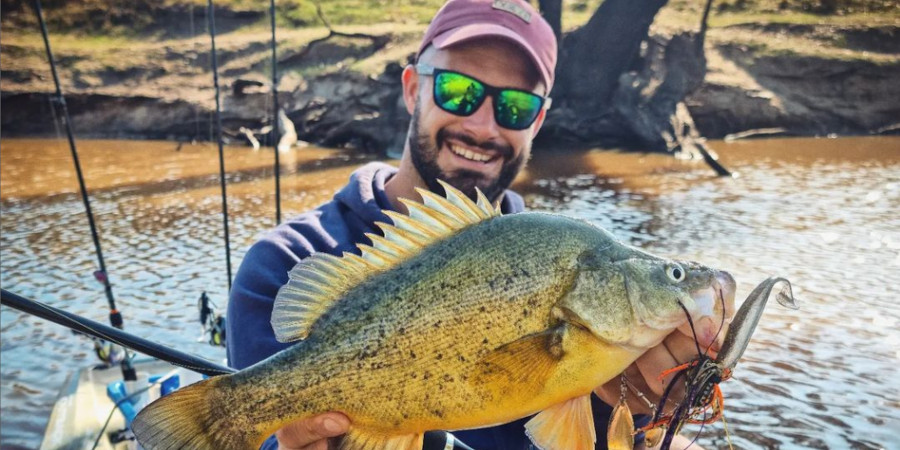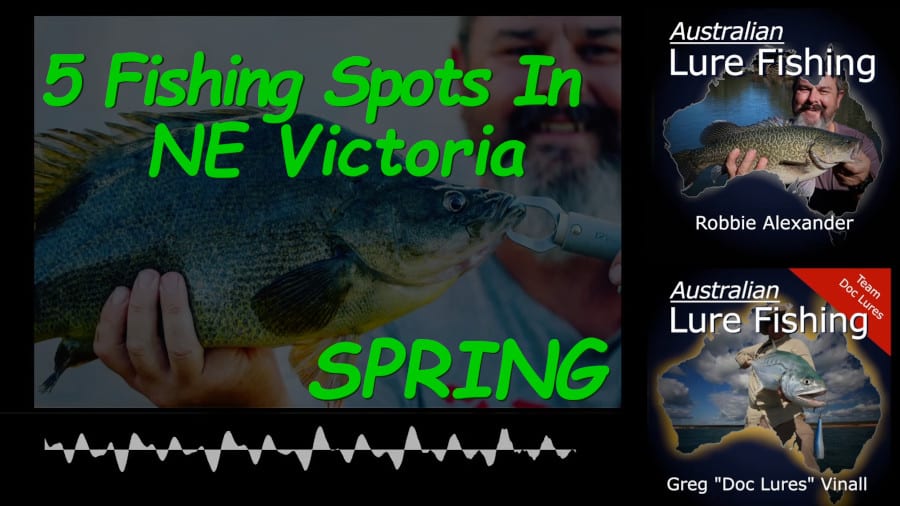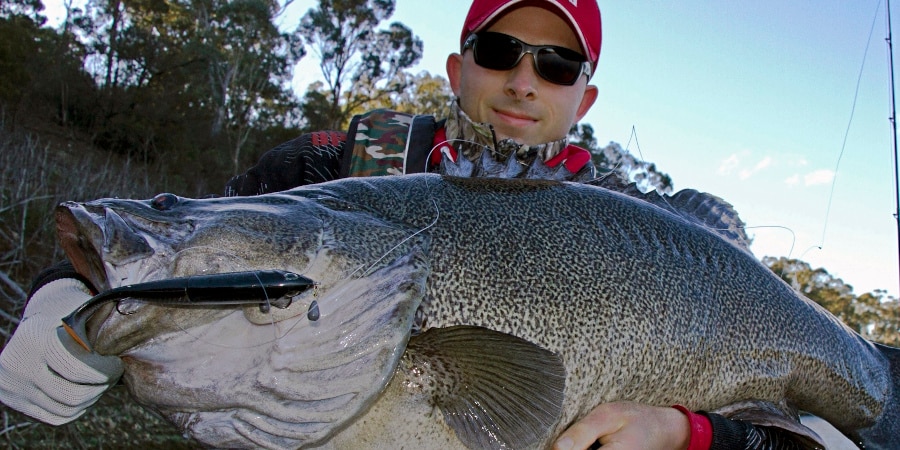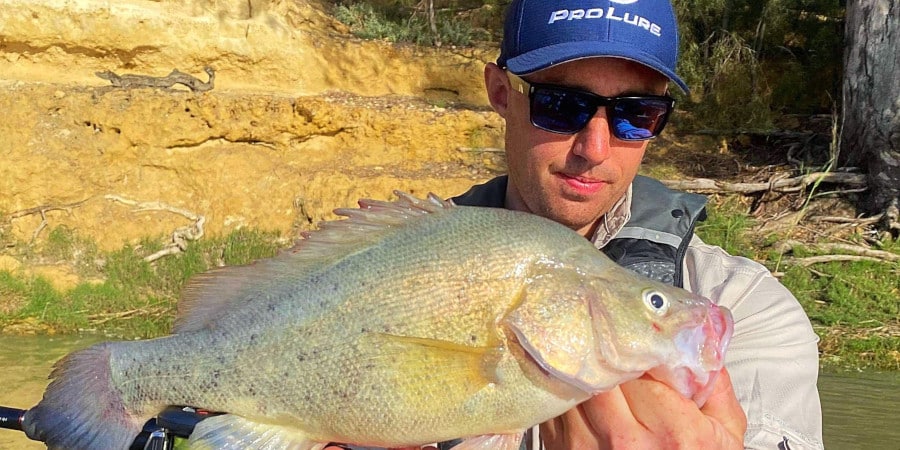
Rory Benn-Clibborn
Native Freshwater Gun And Lure Maker
Rory grew up fishing the ACT and central NSW for native species and spent many years based in Canberra and fishing for yellas. He’s since moved to Melbourne, where he runs his lure making business and enjoys the finesse fishing species available in that part of the world.
Rory’s Golden Perch Fishing Tips
- Golden perch fishing is not always about bankside structure. Advances in sonar over the past decade have brought deeper water structure and fish into focus. During the late summer and early autumn period the fish will often be on deeper flats or points, and it can be possible to map and follow a school of fish for a month or two. Lake Burley Griffin is a good example.
- Once you’ve found fish on a particular depth contour it can pay to keep looking at the same depth on similar pieces of structure around the lake – fish will usually be at the same depth right around the system.
- Birds aren’t just important for offshore anglers, they are good indicators of where to fish for native species also. If there are gulls, cormorants and pelicans working then the odds are that there will be bait around and yellowbelly won’t be far away.
- The peak fishing times around Canberra in Autumn tend to be mid to late afternoon, from around 3pm as the sun starts to dip, winds change and conditions favour the yellowbelly. A slight breeze will ripple the surface and help mask the noise of anglers in a boat. Cloud cover isn’t so important as the fish are often deeper and the light is already dim at 6-7m.
- Golden perch can be very passive feeders, so it pays to let your lure sit on the bottom for long periods. Thirty seconds is not too long to leave the lure on the bottom and not moving it other than a bit of a twitch of the rod tip occasionally. A little scent can help, watch your line for signs of a “tick” and be ready to set the hook.
- Soft plastic lures are very handy in lakes that get a lot of pressure as they have a different vibration and don’t have loud rattles. Rory loves using American and Japanese fishing techniques such as drop shotting – there are lots of techniques that have been used effectively overseas for decades but are rarely used in Australia.
- Texas rigged weedless craws are another good example of an American technique that works well in Australia. A tungsten bullet lure is let run free on the leader and can slide down to the worm hook. This rig allows the sinker to slide up the line after casting, so when the sinker hits bottom the lure is left to flutter down unweighted and is generally taken at that point by the yellowbelly.
Rory’s Golden Perch Fishing Tackle
- For fishing vibes and blades a fast action 1-3 or 2-4kg spin stick with a 1000-2500 size reel, 6-8lb braided line and a 6lb fluorocarbon leader is perfect.
- A 7’ ultra-light rod with a parabolic action, 1000 size reel and 4lb straight through fluorocarbon is great for drop shotting or fishing a weedless soft plastic crawfish.
Rory’s Top Golden Perch Lures
- A Jackall TN60 soft vibe is a must-have in most yellowbelly anglers lure boxes, in both silent and noisy versions. Most people prefer to fish the rattling TN60 first in the hopes of drawing fish from a distance and then switch to a silent lure if they’re not getting the bite. This is an effective search tool when cast out, allowed to sink to the bottom and slow rolled back. They can also be cast parallel to the bank and snapped back with a couple of hops or can be dropped vertically onto fish too.palm perch lures
- An Ecogear ZX40 metal blade has a different vibration signature than the soft vibe and can be deadly on yellowbelly. Rory likes to fish this lure ultra slowly, barely lifting it off the bottom with long pauses and some shakes of the rod to stir up some silt and attract fish to slurp them off the bottom. If that’s not working it’s worth ripping them up a bit more to increase the vibration.
- The Berkley Gulp Grub in black colour and sizes of 70-100mm is another staple among yellowbelly specialists, especially around standing timber where they can be dropped to the base of a tree and then worked back up vertically. Rory finds that they are also a great weapon when the fish are in deeper water, where they can be slow rolled up off the bottom. Yellowbelly will often follow them up from the bottom and grab them as they are approaching the last couple of metres from the surface. The plastic doesn’t necessarily have to be a black Berkley Gulp, other curl-tail grubs are also effective and other colours work well too.
Recent Yellowbelly Episodes

Episode 615: Wimmera Yellowbelly With Mitch McMaster
Victoria’s Wimmera region is a well kept secret when it comes to Australia’s freshwater natives. Fortunately, Mitch McMaster has them figured out and doesn’t mind sharing a few tips!

Episode 539: Top Fishing Spots In NE Victoria During Spring With Robbie Alexander
NE Victoria starts to fire up during the spring period and Robbie Alexander wastes no time taking advantage of the yellowbelly, cod, redfin and trout opportunities that become available. In today’s interview Robbie shares his best advice for top spring time fishing spots.

Episode 520: Five Best Winter Fishing Spots Around Canberra With Romen Dicovski
Winter fishing around Canberra might be a chilly affair, but the locals know it’s when some of the best fishing and the biggest cod, yellowbelly and redfin are caught!

Episode 519: Five Best Fishing Impoundments In South Australia With Alex Williams
South Australia’s impoundment native fishery is relatively new but is shaping up to be something really special! Alex Williams takes us to the best five impoundment fishing destinations in SA today and explains exactly how to go about targeting some iconic aussie species.

Episode 437: Albert Park Lake Yellowbelly With Andrew Foudoulis
Albert Park Lake might be nestled right in the midst of a metropolis, but it also offers an wonderful and accessible opportunity for Melbourne anglers. Andrew Foudoulis has used the Melbourne lockdowns gainfully to figure out how to target this species in APL.



0 Comments